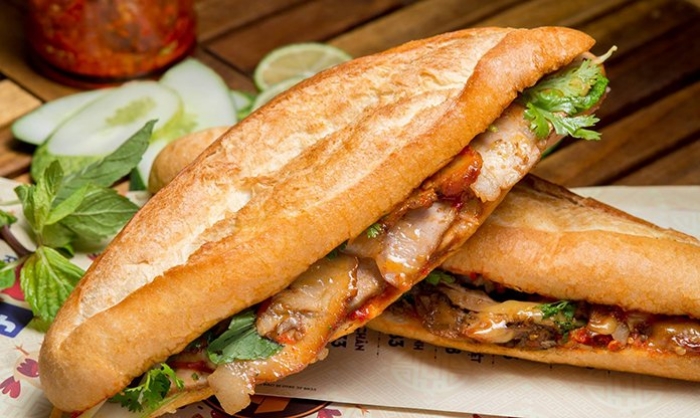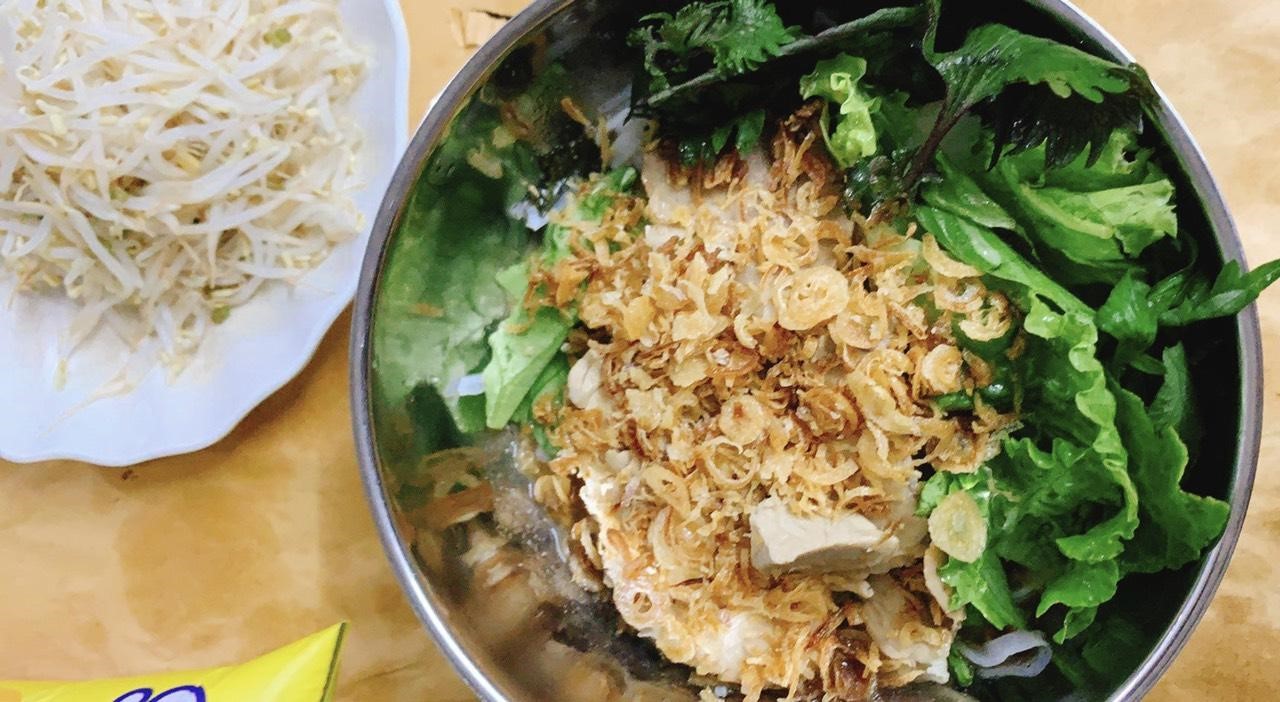(TITC) - The 10 most interesting delicious dishes in Ho Chi Minh City are in “Ho Chi Minh City - 100 interesting things” announced by the Department of Tourism in early December 2023, as a suggestion for visitors to explore the city’s cuisine.
The list is based on more than 104,000 votes for 10 categories including sightseeing tour programmes, attractions, entertainment spots - entertainment programmes, shopping spots, tourist accommodation establishments, restaurants - eateries, cafes, check-in points, tourism-culture-sports events and delicious dishes.
Banh mi

Photo: Vinpearl
Banh mi is one of the familiar, easy-to-eat and convenient dishes. In Ho Chi Minh City, banh mi has many variations, helping to satisfy the taste buds of diverse diners. You can try shumai banh mi, pork skin banh mi, fish cake banh mi, roasted pork banh mi, grilled beef banh mi, and shredded chicken banh mi.
You can find many famous bakeries in Ho Chi Minh City, existing for more than half a century. Bay Ho Bakery opened in 1930, and after more than 90 years, it still maintains the same recipe as the first day. Hoa Ma Banh Mi is famous for its pan banh mi, serving for 60 years. There are also many other shops worth trying such as Huynh Hoa banh mi, Tang banh mi, Cu Ly banh mi, and Sau Le banh mi.
Mixed rice paper
Ho Chi Minh City mixed rice paper is made from pieces of rice paper that have been dried in dew and cut into small pieces. After cutting, rice paper is mixed with shredded green mango, finely chopped laksa leaves, Tay Ninh shrimp salt and kumquat juice squeezed in. Add to the bag of rice paper a little bit of fried onion fat with peanuts and roasted shrimp to enhance the flavour. In addition, this dish will lose its taste without quail eggs and dried beef fibres. Depending on taste, the maker will add more or less satay.
Visitors to Ho Chi Minh City can find mixed rice paper at familiar addresses such as Turtle Lake, Nguyen Thuong Hien Street (District 3), September 23 Park (District 1), Ben Thanh Market area, intersection of Nguyen Thai Hoc - Tran Hung Dao streets (District 1). Diners can order additional quail eggs, beef jerky, and rice paper and the price varies depending on the quantity.
Crispy pancakes (Banh xeo)

Photo: TITC
Banh xeo is a must-try dish when visiting Ho Chi Minh City. In a city where many cultures and regional cuisines intersect, banh xeo in Ho Chi Minh City is divided into two main types: Central pancake and Western pancake. Banh xeo of the Central region is small, less than a hand in diameter, filled with green beans, bean sprouts combined with some seafood or pork. Western pancakes are large in size, filled with shrimp, pork belly, bean sprouts and green beans.
Beef noodle (Bún bò)
Visitors can enjoy various beef noodle in Ho Chi Minh City. The first one is Bún bò Nam Bộ (Southern beef noodle). This is one of the popular dishes of Southern people, it also has another name: stir-fried meat noodle. Unlike Hue spicy beef noodle soup, the special feature of southern beef noodle dish is brothless, with small noodles. The noodles will be served with spicy and sour chili garlic fish sauce, and topped with thinly sliced stir-fried beef. This dish is often enjoyed with many herbs such as bean sprouts, cucumbers, fried shallots, roasted peanuts...

Bún bò Nam Bộ (Photo: TITC)
Another type of Bún bò is Hue spicy beef noodle soup that was once recognized by famous chef Anthony Bourdain as one of the most delicious dishes in the world. Attractive noodle bowl with rich, spicy broth, inside is beef with pork sausage, fresh vegetables. Spicy beef noodle soup followed the Hue people to Ho Chi Minh City. During the process of introduction, three popular styles were formed. The first type is a bowl of vermicelli with lots of meat and rolls, which looks fuller than in Hue. The broth has a sweet taste of sugar, reducing the strong smell of shrimp paste. Diners can find Kim Long beef noodle shop, Tran Quang Dieu Street (District 3).

Hue spicy beef noodle soup (Photo: TITC)
The second style retains the taste of the original dish in Hue, the broth is rich in lemongrass and fish sauce. Restaurants that cook this type can go to Ngu Binh beef noodle soup, Nguyen Van Troi residence (Phu Nhuan district), Ut Hung restaurant, Tu Xuong street (District 3). There is another type of beef noodle soup that usually does not have or uses a little fish sauce and broth. Toppings are sliced pork rolls, beef, and large pieces of pork trotter. Diners who like to eat this way can visit Song Anh beef noodle restaurant, Ban Co Street (District 3), Nhan Tri beef noodle restaurant, Le Hong Phong Street (district 10).
Various of sticky rice
In Ho Chi Minh City, sticky rice is sold at all times of the day: noon, afternoon, evening or late at night, early in the morning to satisfy diners. There are many different versions of sticky rice, but it is mainly divided into two types: meat sticky rice and sweet sticky rice.
Sweet sticky rice like sticky rice with beans, durian, corn, and Sweet Gourd. The typical dish always has a layer of soft, hot fragrant sticky rice with a little grated coconut rice and a layer of granulated sugar and roasted peanuts on top. Corn sticky rice is one of the typical sweet sticky rice dishes, made from sticky sticky corn stewed with coconut water to make the seeds soft and bright white. Corn sticky rice is a bit mushy. When eating, add a little grated coconut, sugar, peanuts or sesame salt. It’s both sweet and fatty but not greasy.
Another type of sweet sticky rice in Ho Chi Minh City is cadé sticky rice, sticky rice stuffed into fresh banana leaves, topped with a soft layer of cadé made from coconut milk, eggs, flour, and sugar. The seller cleverly packages it beautifully.
Meat sticky rice in Ho Chi Minh City is usually cooked and served with xa xiu (roasted pork), dried shrimp, sausage, meat floss, pork rolls, quail eggs, added with fatty onions or fried shallots, and drizzled with rich sauce. The typical version is chicken sticky rice. A box of sticky rice adds marinated chicken thighs, onion fat, pickled mustard greens and a well-cooked sauce. Diners can choose many side dishes such as crispy fried chicken skin, young eggs, shredded chicken, shumai, and boiled gizzard liver.
Sweet Soup

Photo: Vinpearl
Sweet Soup is a familiar dish for Vietnamese people and in Ho Chi Minh City there are countless types of sweet soups for diners to enjoy. There are dozens of flavoured sweet soup dishes such as lotus seed, green beans, red beans, peanuts, black sesame, longan, ginkgo, water chestnut, ginseng tonic, Quy Linh Cao, and braised chicken egg (like flan), chicken egg soaked in black tea, steamed papaya. Diners can find long-standing sweet soup shops such as the 80-year-old Cot Den Sweet Soup shop on Tran Hung Dao Street (District 5), and Lam Vinh Mau Sweet Soup cart on Nguyen Thai Binh Street (District 1).
Ho Chi Minh City also has a street specialising in selling Thai Sweet Soups, which is the area of Nguyen Tri Phuong Street (District 10). Thai Sweet Soup has a unique flavour with the smell of durian, accompanied by a sweet and fatty milk taste. If you want to enjoy sweet soup with Southern flavours, you can visit the sweet soup shop on Su Van HanhSstreet. Here, they serve 16-cup trays of flavours such as Ba Ba sweet soup, regular sweet soup (made from beans), banana sweet soup, corn sweet soup, white bean sweet soup, taro sweet soup, and dumplings sweet soup, accompanied by a jar of coconut jelly, a plate of sticky rice, and a plate of flan. Customers eat individually by cup, and pay as much as they eat.
Broken rice (Cơm tấm)

Photo: Vinpearl
Cơm tấm is a familiar dish to many generations of people in Ho Chi Minh City. You can eat broken rice for breakfast, lunch or dinner. A delicious plate of broken rice will include a little dry, small grain rice, a few slices of cucumber, pickles and on top are grilled ribs, pork skin, and pork patties. Broken rice in Ho Chi Minh City also has a wide range of prices, this popular dish goes from the sidewalk to luxury restaurants. The soul of this dish is the sweet, candy-like fish sauce. Diners soak the hot rice in fish sauce and eat it with the toppings they ordered. Depending on the amount of rice, the size of the ribs, and the number of toppings ordered, the price of the rice will vary.
Some delicious broken rice shops that diners can refer to include Tai broken rice on Nguyen An Ninh street (Binh Thanh district), Mai broken rice on Doan Van Bo street (District 4), Ba Ghien broken rice on Dang Van Ngu street (Phu Nhuan district).
Nam Vang noodles (Hủ tiếu Nam Vang)
Hủ tiếu Nam Vang is a dish that originated from Phnom Penh and was prepared by Khmer people, then was imported to Vietnam and became famous, especially in Ho Chi Minh City, there are many noodle soup restaurants that are popular with locals and international tourists. Soft, chewy rice noodles are made from rice flour, boiled in boiling water and served with a rich broth including prawn, minced pork, pork intestines, quail eggs, served with fried garlic and raw vegetables blended together to create an irresistible dish of all time. People often have Hủ tiếu Nam Vang in the morning or afternoon. You can easy find one on the streets of Ho Chi Minh City because this is a very popular dish in this place.
Snail
Ho Chi Minh City not only has snails, boiled stuffed snails dipped in ginger chilli sauce but also has many other types such as spotted babylon snails, bailer shell snails, tomlinia frausseni snails. Each type of snail also has a variety of ways to prepare snail dishes such as steaming, boiling, stir-frying, frying, roasting, grilling, salted egg sauce, and tamarind sauce.
To Hien Thanh Street (District 10), Nguyen Thuong Hien Street (District 3), and Vinh Khanh Food Street (District 4) are three addresses for snail lovers in Ho Chi Minh City. In addition to snails, there are many other types of seafood for diners to enjoy such as oysters, crabs, sentinel crabs, prawn, and squid.
Pho

Photo: TITC
The history of pho can be traced back to the early 20th century in the Northern provinces and Ha Noi said to be the first place where this dish appeared. Pho was introduced to Ho Chi Minh City, gradually becoming a familiar dish to residents and tourists here. Pho restaurants in Ho Chi Minh City are divided into two schools: Southern pho and Northern pho. Northern pho restaurants have light, clear and less sweet broth. Pho Bac focuses on natural flavours, so the quality of fresh beef is the highlight. Southern pho is usually sweeter and more flavorful. The broth is darker due to the addition of grilled purple onions and many combined spices. Southern pho is often served with bean sprouts, raw vegetables, sliced onions, garlic and soy sauce.
Tourism Information Technology Center